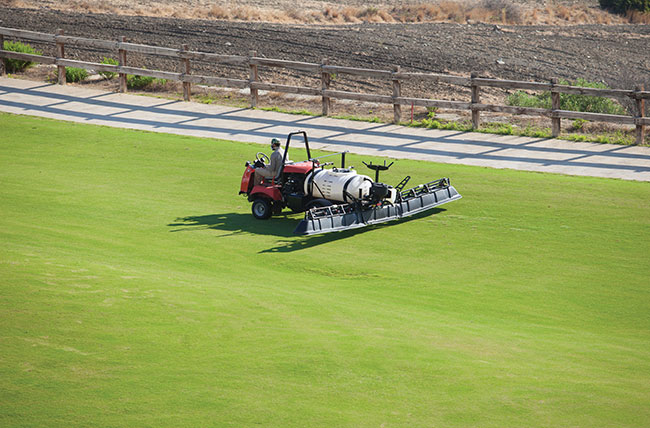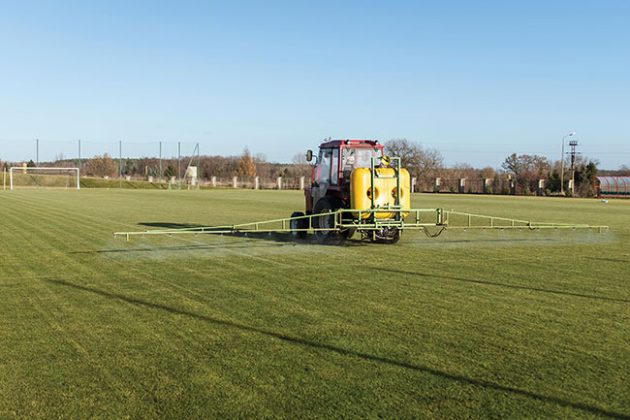
Features
Equipment
Keep sprayers clean for top performance in golf, sports turf
Turf managers must protect their investment through regular cleaning
May 9, 2022 By Ryan Beauchamp
 A sprayer at work on a golf course fairway. Regular cleaning of sprayers is the key to its return on investment and ensures there are no issues with the product being applied. Photo credit: Dziurek/Adobe Stock
A sprayer at work on a golf course fairway. Regular cleaning of sprayers is the key to its return on investment and ensures there are no issues with the product being applied. Photo credit: Dziurek/Adobe Stock Outside of labour, the largest operational costs for a turf manager are the products applied through a turf sprayer. This includes fertilizers, surfactants and plant protectants. Because of their high value, it is critical for managers to protect their investment with proper application and avoid issues caused by equipment that isn’t running smoothly.
Maintain sprayer performance
Sprayer cleanout removes fertilizer and pesticide residue in your equipment that can cause lines and nozzles to clog and/or cause turf damage during subsequent applications. Sprayer cleanout allows your equipment to continue to perform properly each and every time you use it.
Regular cleaning intervals
Sprayers should be cleaned after each application is complete and before switching to a new product application. Sprayers should be cleaned at the end of every workday to prevent buildup of residues in the equipment that may become more difficult to remove later. New, demo or borrowed equipment always requires an initial cleanout. You should also clean and winterize your sprayer prior to winter storage.
Personal safety and protection
Always wear personal protective equipment, including chemical-resistant gloves, boots, an apron, and a face shield or goggles. Make sure your protective equipment is clean and is being worn correctly. Clean your sprayer in an area that is not used by people or animals, and not in an area close to water sources such as ponds, ditches, creeks or wells. Stay away from catch basins that might cause rinsate to enter and contaminate water courses. Avoid leaving rinsate water puddles where children or animals may encounter them.
Standard cleaning procedures
Clean the entire sprayer, including the tank, chemical inductor (side tank), valves and hoses. If the end of the boom extends beyond the last nozzle, residues may collect in this area. Remove boom end caps and collect any solids that have accumulated. Label this container as agricultural chemical residue, store it safely in your pesticide storage and dispose of the product properly at the next obsolete pesticide collection program in your province.
Replace the boom end caps. Missing any of these areas during cleanout could result in damage during later applications. Following the first rinse, use gloves to inspect and place all screens, filters and nozzles into a pail and clean with a small brush using the same solution as used in rinse number two (see Triple Rinse Cleanout Procedure below). Use this pail only for this cleaning and label it as such. Rinse these items with clean water prior to replacing them into the sprayer for the third rinse.
Place rinsate from the pail into the sprayer for disposal. Don’t forget to clean your measuring containers at the same time and in the same manner. Remember that improper mixing sequence creates additional application issues.

A triple-rinse cleanout process is recommended to ensure sprayers are cleaned thoroughly.
Cleaning products
Each pesticide label will have directions about what cleaning product to use, quantity to use and how to use it. Usually, this information is located near the end of the label. If you cannot find the label directions, contact the manufacturer listed on the front of the chemical label for advice. Each product has specific recommendations for best cleanout results.
Follow the cleaning product label’s directions for safety and mixing directions. Some labels may require the cleaning solution to remain in the tanks and hoses for extended periods, such as overnight. Remember, your goal is to remove dried residues, solubilize oily residues and reduce corrosion.
Clogged nozzle damage
Typical cleaning products used per 100 gallons:
- Water only, if not specified on the label, or
- 3 kg (TSP) trisodium phosphate cleaner detergent, or
- Commercial tank cleaner, such as Inside-Out from Precision Lab Inc. (follow instructions)
Triple rinse cleanout procedure
Cleaning a sprayer is similar to cleaning pesticide jugs for proper disposal, which is a triple-rinse procedure.
- Rinse One (Rinse): Fill tank 10 per cent full of clean water and circulate in the sprayer for a minimum of 10 minutes. Remove boom ends where possible, and flush out booms, filters, screens and nozzles. When tank is empty, remove nozzles, filters and screens as outlined above.
- Rinse Two (Clean):> Fill tank 10 to 15 per cent with clean water and then add the cleaning product as directed by the product label. Be certain to rinse any chemical inductors while doing each of the three rinses. Run the sprayer for a minimum of 10 minutes, flushing the cleaning solution through each boom and the entire sprayer.
- Rinse Three (Rinse Again): Replace all screens, filters and nozzles and repeat rinse number one as outlined above, and run solution through all booms. Wash the exterior of sprayer with soap and water.
Proper disposal
It is recommended that sprayer rinsate is applied to the same areas where that chemical has just been recently applied. Application here allows any tank residue to break down in a known manner and does not apply product above the recommended label use rate. application issues.
Winterization
After the final rinse, add a plumbing anti-freeze mixture into the tank. Never use automotive anti-freeze. Use a product such as Recochem Inc. Sprayer Winterizer for farm equipment. Always follow your sprayer manufacturer’s directions. This usually includes circulating this mixture through your entire sprayer, including booms and nozzles, using agitation for at least five minutes and then draining. Make sure there is no water left in the system. Consult your municipality for proper disposal of the plumbing anti-freeze or follow the manufacturer’s directions for disposal of the product.
Even the most thorough cleaning procedures will always have some inherent limitations that keep them from being 100 per cent effective. By following proper procedures and regular maintenance schedules, you can extend the life of your equipment, keep it running properly, and prevent costly downtime and product loss.
Ryan Beauchamp is territory sales manager with Bayer Environmental Science Canada. He can be reached to answer any questions about this article or sprayer cleaning strategies by email at ryan.beauchamp@bayer.com. Questions can also be asked of any local territory sales manager with Bayer.
Print this page